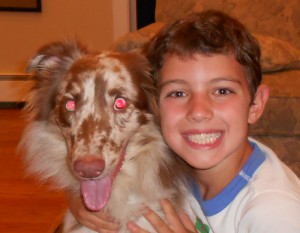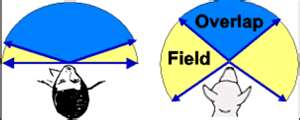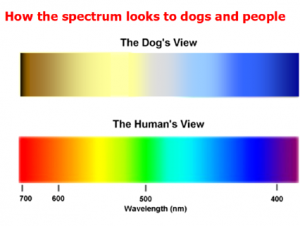I can’t believe the way time has sped along here in the Northeastern United States. We have gone from storm to storm this year, enduring “hurricanes” in the summer to heavy snow at Halloween which combined for almost 2 weeks of life without power at both my home and the clinic. No good sales on generators this holiday season you can bet! Thanks to battery powered equipment, we were able to cobble together a service for those of you with non-surgical problems that inspection, conversation and medication could provide an answer. Thanks to all who survived these times and even greater hardships. We fortunately had no structural damage here or at our homes and hopefully most of you did as well. And if you did, I also hope you had a community of family and friends to get you through.
So as we look forward to a winter season ahead (more tame than last?), I thought I would talk a bit about what dogs see when they look ahead. We commonly get the “are dogs color blind?” question and occasionally deal with visual acuity issues, so a little education on the subject seemed timely.

VISION IN THE DOG
When we talk about vision in any animal, the first thought that needs to come to mind is “what does this animal do?”. In fact, just about every adaption within a species is there to facillitate it to do its job. I took a course at UC Davis when I was an undergrad called The Functional Anatomy of Vertebrate Structure. Within that course, we examined primarily the bone structure of different animals to see how it helped them fly, dig, swing or swim, for example. Adaptations such as hollow bones in birds to decrease their weight to help them fly or large flat bones to increase the surface area of the feet of turtles for pushing water were some of the many differences that we investigated. The same goes for the eye. Some animals hunt in the dark, others have to adapt to both a water and air environment, some must be able to focus accurately and quickly as they move through a complex environment. And yet the basic anatomy of the eye is same. A dog’s vision is different than ours because dogs are built to perform different tasks from a different perspective for a different reason. A fascinating book by a fellow named Walls called the Vertebrate Eye and its Adaptive Radiation gives his view on the subject of anatomical adaptations from an ocular standpoint. Let’s look at some of these variations that make the dog’s vision different than ours.
![dogsees-sm[1] dogsees-sm[1]](http://www.aecwilton.com/wp-content/uploads/2012/01/dogsees-sm1-287x300.jpg)
Perspective is a good place to start. We perceive our world from on average 5-6 feet above the ground. Some small dogs may be inches above ground and others are up to waist-high level for some big dogs. Think of your children walking through a crowded event with their noses in the backs of the adults also in line. Many dogs will be in a similar line of sight when the grass is high and they are running through a field. Or how about the Shih Tzu or Sheepdog with the long haircut covering their eyes? Not only are they operating from a low vantage point, they have a curtain of thick hair to peer through. The following three pictures are taken from the exact same location just different heights off the ground to give you an idea of what your dog may be seeing. Take into consideration this does not reflect total field of view, focus or color, just the forward perspective!

Small dog perspective

Medium-sized dog perspective

Average human view
Field of view and a feature called binocular overlap become important. The more forward your eyes are placed on your skull equates to better stereo vision and depth perception but you see a smaller amount of space around you. Predators commonly have more forwardly placed eyes so they can focus accurately on their prey when attacking. Prey, on the other hand, often have eyes placed more on the sides of their head, like a rabbit for example, so that they can see the predator sneaking up behind them. Their only defense is often to run early before the strike if they can detect the stalking prey. Dogs have forward placed eyes that give them a visual field in front of them that is approximately 240 degrees wide with 60 degrees of binocular overlap. Humans, for comparison, have a smaller visual field of 200 degrees but 140 degrees of binocular overlap since our eyes are more forwardly placed.

Visual acuity and color vision are features that are commonly assessed in people and thus our curiosity leads us to question if they are similar in our pets. It is difficult to determine these values in non-verbal patients, but there are many tests to evaluate how well an eye focuses and processes light. Simply put, the ability of the lens to focus light on the retina and the retina’s sensitivity to this stimulus create acuity.
Different species have various ranges of accomodation, meaning whether they can focus on something in the distance as well as focus on something close by without aid. The lens can change shape via muscles and their attachments to the lens which allows it to focus. Some species may even move the lens backwards or forwards to acheive the same goal. Think of a nice camera where we twist the lens to focus the image in the viewfinder. We are changing the distance from the lens to the film until the image is sharp. Our lens does the same thing as we try to read a book. We may be able to relate to the need for reading glasses as we age which relates to stiffening of our lens and its inability now to change shape enough to focus clearly on the film, our retina. Different species can change the shape of their lens to different degrees base on their environment and needs. In addition, the resting shape of the lens varies from completely round (fish) to more oval (humans) or even bell-shaped (some owls) depending on the environment in which they live. Dogs have a more oval lens like us but less ability to change its shape and thus have a smaller range of accomodation.

The retina plays a role in image quality as well with the number, type and density of the rods and cones accounting for its function. This is a very complex area that is difficult to summarize, but dogs have a rod-rich retina which makes them better for seeing in low light and for movement. The cones are better for color vision and acuity. We have a cone-rich retina with a macula, an area with a high density of cones that is the “sweet spot” of our vision. Dogs don’t have a macula but rather a strip of retinal tissue that is more cone dense than the surrounding region but not as dense as a macula. In addition, dogs have a tapetum which is a reflective layer that helps amplify light which is another mechanism in addition to the rods to help them see when the lights are dim. Color vision is not too helpful for them for hunting and finding a mate, like in birds for example, so they are a little red-green color blind but still see a yellow-blue spectrum. I guess if dogs were more brightly colored and ate pretty flowers for dinner, their retinas may have evolved to differentiate those colors as well. But a brown dog looking for a brown meal or mate doesn’t really need good color vision to survive and thus genetics have moved them another direction. All things considered, dogs are best corrected at 20/80 meaning what we see clearly at 80 feet, they need it to be 20 feet away from them to be in clear focus. Glasses won’t improve this since the limitation is at the level of the retina, not the lens.
I could go on and on about species differences in vision but I think you get the idea. Our sensual world is different than a dog’s but we both do fine with our limitations and our specializations. Wouldn’t it be cool to experience their world for a day? I wonder what we would see, hear and smell then?


